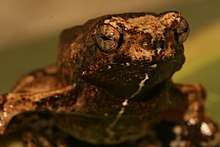Engystomops
Engystomops is a genus of frogs in the family Leptodactylidae.[1] They are known commonly as foam frogs[1] or túngara frogs,[2] though the latter name most commonly refers to Engystomops pustulosus. They are native to the Americas from southern Mexico south to the Amazon Basin.[1][2]
| Engystomops | |
|---|---|
 | |
| Engystomops petersi | |
| Scientific classification | |
| Kingdom: | Animalia |
| Phylum: | Chordata |
| Class: | Amphibia |
| Order: | Anura |
| Family: | Leptodactylidae |
| Subfamily: | Leiuperinae |
| Genus: | Engystomops Jiménez de la Espada, 1872 |
| Species | |
|
9 (see text) | |
| Synonyms[1] | |
|
Microphryne Peters, 1873 | |
This genus was maintained on its own until 1970, when it was merged into Physalaemus, a genus of similar frogs. As studies progressed, there was increasing evidence that Physalaemus was not a monophyletic group; it was made up of several groups. One of those groups consisted of several frogs more closely related to each other than to the rest of the Physalaemus, and they were represented by P. pustulosus, now Engystomops pustulosus. This group was split off in 2005 on the basis of characters such as basic morphology and vocalizations, as well as allozyme and other genetic analysis. The group was given the revalidated name Engystomops. It included two newly described species.[3]
Description
These frogs measure about 1.5[3] or 1.6[4] to 3.5[4] or 3.8[3] centimeters long.
These frogs live on the forest floor. They breed in temporary pools, sometimes in puddles that form during the rainy season.[2] They are perhaps best known for their foam-nest-building behavior, particularly E. pustulosus, in which the behavior has been well-studied. During mating, the male releases sperm while the female releases eggs and a protein-rich fluid. The male vigorously beats the fluid into a foam with his feet. The eggs are suspended in the foam, which acts as a protective matrix. Some of the proteins have surfactant properties, keeping the foam mass stable on the water, while others likely have antimicrobial and antiparasite properties.[5]
Frogs of this genus have been researched in studies of sexual selection and communication in animals.[6]
It was previously believed that a female's choice in Engystomops benefited through indirect exclusion but it is now believed that the extra male activity while nesting influences the fitness of the female directly. Thus creating the operation of sexual selection through direct benefit.[7]
As of early 2018, there are nine species in this genus:[1]
- Engystomops coloradorum (Cannatella and Duellman, 1984)
- Engystomops freibergi (Donoso-Barros, 1969)
- Engystomops guayaco (Ron, Coloma, and Cannatella, 2005)
- Engystomops montubio (Ron, Cannatella, and Coloma, 2004)
- Engystomops petersi Jiménez de la Espada, 1872
- Engystomops pustulatus (Shreve, 1941)
- Engystomops pustulosus (Cope, 1864)
- Engystomops puyango Ron, Toral, Rivera, and Terán-Valdez, 2010[8]
- Engystomops randi (Ron, Cannatella, and Coloma, 2004)
It has been suggested that E. pustulosus is a cryptic species complex,[6] and E. petersi may be, as well.[9]
References
- Frost, Darrel R. (2017). "Engystomops Jiménez de la Espada, 1872". Amphibian Species of the World: an Online Reference. Version 6.0. American Museum of Natural History. Retrieved 15 January 2018.
- Romero-Carvajal, Andrés; Sáenz-Ponce, Natalia; Venegas-Ferrín, Michael; Almeida-Reinoso, Diego; Lee, Chanjae; Bond, Jennifer; Ryan, Michael J.; Wallingford, John B. & del Pino, Eugenia M. (2009). "Embryogenesis and laboratory maintenance of the foam-nesting túngara frogs, genus Engystomops (= Physalaemus)". Developmental Dynamics. 238 (6): 1444–54. doi:10.1002/dvdy.21952. PMC 2934778. PMID 19384855.
- Nascimiento, L. B.; Caramaschi, U. & Cruz, C. A. G. (2005). "Taxonomic review of the species groups of the genus Physalaemus Fitzinger, 1826 with revalidation of the genera Engystomops Jiménez de la Espada, 1872 and Eupemphix Steindachner, 1863 (Amphibia, Anura, Leptodactylae)" (PDF). Arquivos do Museu Nacional, Rio de Janeiro. 63 (2): 297–320.
- Ron, S. R. (2008). "The evolution of female mate choice for complex calls in túngara frogs" (PDF). Animal Behaviour. 76 (6): 1783–94. doi:10.1016/j.anbehav.2008.07.024.
- Fleming, R. I.; MacKenzie, C. D.; Cooper, A. & Kennedy, M. W. (2009). "Foam nest components of the tungara frog: A cocktail of proteins conferring physical and biological resilience". Proceedings of the Royal Society B: Biological Sciences. 276 (1663): 1787–1795. doi:10.1098/rspb.2008.1939. PMC 2674504. PMID 19324764.
- Ron, Santiago R.; Santos, Juan C. & Cannatella, David C. (2006). "Phylogeny of the túngara frog genus Engystomops (=Physalaemus pustulosus species group; Anura: Leptodactylidae)". Molecular Phylogenetics and Evolution. 39 (2): 392–403. doi:10.1016/j.ympev.2005.11.022.
- Narváez, Andrea E.; Ron, Santiago R. (2017-01-25). "Spawning behaviour of Engystomops pustulatus (Anura: Leptodactylidae)". Journal of Natural History. 51 (3–4): 267–275. doi:10.1080/00222933.2016.1251983. ISSN 0022-2933.
- Ron, Santiago R.; Toral, Eduardo; Rivera, Myrian & Terán-Valdez, Andrea (2010). "A new species of Engystomops (Anura: Leiuperidae) from southwestern Ecuador". Zootaxa. 2606 (1): 25–49. doi:10.11646/zootaxa.2606.1.2.
- Azevedo Brito, C. P. T. (2009). Estudo citogenetico e das relações filogeneticas de Engystomops petersi e Engystomops sp. (Anura, Leiuperidae) (Thesis). Instituto de Biologia, Universidade Estadual de Campinas.